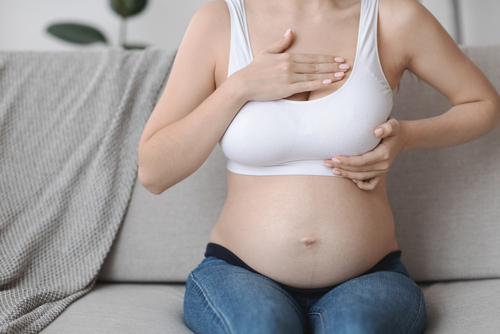Breast changes are a typical feature of pregnancy and are caused by hormonal imbalances. Breast changes can develop as early as one week after pregnancy and continue until the baby is born and beyond.
1. Being breast-aware when pregnant
During pregnancy, your breasts alter to prepare them to nurse your baby.
These modifications are the result of an increase in hormones and may include the following:
- Tenderness or a change in nipple and breast feeling
- Increased breast size
- Color and size variations in nipples and areola
- larger and more visible Montgomery glands
The breasts begin to produce milk about the 16th week of pregnancy.
It’s not uncommon for little quantities of colostrum, a straw-colored fluid, to flow from the nipples.
If you’re concerned about it showing through your clothes, place a breast pad (a disposable or washable fabric cushion) inside your bra.
2. What changes occur in the breasts during pregnancy?
It is critical to be breast conscious both during and after pregnancy.
This entails learning how your breasts appear and feel so you can determine what is typical for you.
This will give you more confidence in spotting any strange changes.
Because breasts fluctuate so much throughout pregnancy, it might be difficult to spot any unexpected changes.
If you have any concerns about a change in your breasts, see your midwife or doctor.
The breast is composed of lobules (milk-producing glands) and ducts (tubes that carry milk to the nipple). They are encased with glandular, fibrous, and fatty tissue. This tissue is responsible for the size and form of the breasts. The areola is the darker patch of skin surrounding the nipple. Montgomery glands are little raised lumps on the areola that generate fluid to moisturize the nipple.
3. How frequent are breast lumps during pregnancy?
Breast lumps can form during pregnancy. The most popular are as follows:
- Cysts (fluid-filled sacs)
- The Galactoceles (milk-filled cysts)
- Fibroadenomas (which develop in the lobules of the breast)
These are non-cancerous breast conditions.
If you had a fibroadenoma before becoming pregnant, it may become larger throughout the pregnancy.
Breast cancer is rare in women of childbearing age and during pregnancy.
However, you should get any new breast lumps or changes to an existing breast lump examined by your doctor.
4. Is it usual to have blood coming out of your nipple?
A few women may experience sporadic blood leaks from the nipple. This is because the number and size of blood vessels has increased.
Although this is typical during pregnancy, it is important to get any blood loss from the breast evaluated by your doctor.
5. Choosing the Correct Bra Size During Pregnancy
As your breasts grow in size, be sure your bra isn’t too tight.
It’s recommended going to a department store or lingerie store to get your bra size tested and verified by a qualified bra fitter.
Alternatively, you might contact the National Childbirth Trust.
A bra is well-fitting if and only if the following conditions are met:
Your breasts fill the cup of the bra, leaving no extra fabric, and it holds the entire breast in place without any bulging at the top, bottom, or sides.
The rear strap does not dig in. The shoulder straps do not support the entire weight of your breasts, keep in position when you lift your arms over your head, and fit snugly against your body without digging.
6. What changes occur in the breasts after birth?
Oestrogen and progesterone levels drop rapidly after a baby is born. Around the third or fourth day after delivery, the colostrum is diluted by extra fluid, making it seem much whiter. Your breasts may begin to leak milk at this time.
When a newborn sucks at the breast, nerves fire, sending instructions to the brain that milk is required. Some women have milk leaks from the nipple when their baby cries or when their breasts are full and they are upset.
This is common in the first few days after giving birth and can be humiliating at times. Using disposable or washable breast pads in your bra might be beneficial.
7. Possibility of post-pregnancy breast issues
The following are some of the issues you may encounter when your milk ‘comes in’ (when your body begins to produce breast milk and no longer colostrum).
Some of this information may be relevant whether or not you decide to breastfeed.
Among the potential issues are:
- Nipples that are sore and cracked
- Engorgement
- Milk ducts that are clogged
- Thrush Mastitis Breast abscess
8. What if I don't want to breastfeed or want to stop?
If you decide not to breastfeed and no milk is expressed, your milk production will cease. For a few days, your breasts may feel heavy, unpleasant, and painful. Wearing a supportive bra and taking pain relievers may be beneficial.
Women continue to make milk as long as they are feeding.
It may take some time for milk production to halt completely when you stop nursing.
Engorgement can occur if you quit nursing too abruptly.
It is preferable to gradually lower the time and quantity of breastfeeds when you wish to quit breastfeeding. You might start by removing one feed every day.
9. Your post-pregnancy breasts
Whether you breastfeed or not, your breasts will most likely not look or feel the same after pregnancy.
You may have gained or lost weight, and it’s fairly uncommon to notice that your breasts have changed in size and form since before pregnancy.
These alterations are part of the regular changes that your breasts go through as you age.
It’s critical that you learn to know how your breasts appear and feel right now so that you can spot any new alterations.


